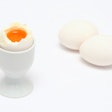“Spreads between product input costs and selling prices for items such as frozen and dried egg products have improved somewhat in recent months, but remain well below historical levels,” he said last month.
The Minnetonka, Minn.-based firm also has been affected by weaker than historical prices in its low and no cholesterol egg products due to competition. To combat these pressures, Ostrander said Michael Foods has an intense focus across the company on cost cutting and growing volumes. That said, company treasurer Mark Witmer said that the company has passed on some business in the frozen and dried egg product market. “We figure it is better not to sell something than to win a bid on volume that clearly has no gross margin in it. Let somebody else do that.”
Looking at the numbers for the firm’s egg products division for the third quarter ended Sept. 30, earnings before interest, taxes, and amortization (EBITDA) were $36.3 million, down 2% from the previous year’s $37.1 million. Net sales of $216.6 million were down $2 million or 1% from the previous year. EBITDA for the nine months ended Sept. 30 were $101 million for the division, down $4.6 million the same period in 2005, with sales of $637.1 million in 2006, down $8.8 million from the nine-month period in 2005. “Overall, to have relatively flat EBITDA given the market conditions out there we feel was a good achievement,” Witmer said.
Witmer said that it is not apparent looking at the results, but the egg products division “actually had nice volume growth in the quarter.” Extended Shelf Life (ESL) liquid product pound units were up 4%, and the precook lines increased by 7%. Even though the patent expired for Michael Foods’ ESL egg product in early September, sales rose with September units up 6% year-over-year. Countering this growth, however, was deflation in five of seven egg product lines.
Looking forward to the fourth quarter, the egg products business remains challenging, Witmer said, but is “a bit better than we’ve seen the past several quarters. That said, lesser losses feel like kind of a hollow victory at best.” He noted that the egg market has been rising rapidly recently, which might provide more challenges as breaking stock is rising faster than product pricing.
On the higher value-added side, he said “we’re seeing volume growth, but are also seeing more price competition than we have seen in a while. October ESL sales were well ahead of forecast and well ahead of October 2005 levels.” Also on the selling front, the company has recently started to offer cage-free products for customers who want such higher-cost specialty items.
One major concern for Michael Foods, Ostrander said, is the recent corn price ramp up “that we think is here to stay for some time due given where ethanol demand is and the subsidies (the ethanol industry) is receiving. That clearly is going to put some challenges on egg product costs. What we’ll have to do as an industry over the next 12 to 18 months is how we get that back in our pricing.” He added that grain prices are going to hold down the number of new birds coming into production.
Witmer said that thanks to hedging activities, fourth quarter feed costs at Michael Foods will only be about 5% higher than the previous year, but greater impacts from expensive corn are likely to be seen in 2007. Ostrander added that “we have no coverage at this point in the new year. Our hedging plans are normally driven coming out of harvest and that is when we look to get hedged into the new year and good, bad, or indifferent, the corn and soybean markets have been on a rapid increase coming out of really the first USDA forecast on the harvest starting back in September. They have been on an upward climb.”
Witmer added that “while we see a good fourth quarter for egg products for EBITDA, the division may not match the prior year’s fourth quarter.”
















